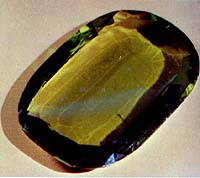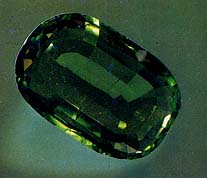Chrysolite - magmatic mineral, transparent garnet olivine
Chrysolite
The chemical formula: (Mg, Fe) 2 [SiO4].
Shingonia: rhombic.
The shape of the crystals is usually prismatic-dipyramidal. Well-formed crystals are very rare, usually chrysolite is represented by granular aggregates with irregular, isometric grains of 2-15 mm in size.
Color: golden green, sometimes with a yellow, herbal, olive, brown tint. Green coloration is caused by ferrous iron, and its brightness and intensity depend on the presence of nickel ions.
Hardness: 6,5-7, fragile; Viscosity and hardness vary in different directions.
Density: 3.0-3.5 g / cm3 (increases with increasing FeO content), chrysoberyl is characterized by low density.
Cleavage: imperfect.
Fracture: shell.
Glitter: glass.
Transparency: transparent.
The refraction is: ng = l, 669-1.975, nm = 1.651 - 1.865, np = 1.636-1.827.
Birefringence: 0.033-0.048.
Dispersion: 0.020.
Pleohroizm: weak.
Absorption: 497, 495, 493, 473, 453 nm (the brightest).


Chrysolite. 192.6 ct. One of the seven historical stones stored in the Diamond Fund, Moscow.
Chrysolite faceted. 10 carats. The Kugdinskoye field
Chrysolite is a magmatic mineral. Its name came from the Greek. Hriss - gold and lithos - stone. The synonym is olivine. Chrysolite is a transparent variety of olivine.
Chrysolites of bedrock deposits, in contrast to those found in placers, are intensely uniformly colored. However, in the same field, their coloration can be different. So, in the kimberlite pipe "Udachnaya" there are both light green and brown chrysolites. Used chrysolites in jewelry for a long time. On the field of olivine on one of the islands in the Red Sea, Pliny the Elder mentioned in the Natural History (23-79 AD).
Jewelry from chrysolite found during archaeological excavations in Alexandria. Known chisoliths of the period of the Greek ancient culture. Crusaders brought to Europe magnificent jewelry with chrysolite. Along with the emerald, it was in great demand at the beginning of this century. In modern jewelry production, chrysolite in the form of faceted inserts, more rarely cabochons, is used in gold products. The conventional form of its faceting is diamond, less often stepped.
Magnificent chrysolite is in the Diamond Fund. Its color is olive-green, the crystal is exceptionally clean, almost without defects (several thin cracks that do not reach the surface of the stone), the shape is elongated, the perimeter dimension is 5.2x3.5 cm, height 1.05 cm, weight 192.75 ct. A large, slightly convex platform is surrounded by stepped faces. The pavilion's facet consists of numerous irregular quadrangular faces.
In the CIS, chrysolite was mined in placers of the Ural rivers. It is found in the bedrock among the traps in Eastern Siberia, in diamondiferous kimberlite pipes of the Yakutsk diamondiferous province, in the clinohumite-serpophite-phlogopite-olivine veins of ultrabasic - alkaline intrusions (the Kugdinskoye deposit). According to the technical requirements for jewelery chrysolite in raw materials, the first class includes crystals or grains of green, yellowish and bright olive green color with dimensions of a defect-free area of 5x5x5 mm.
Defects of chrysolite: cloudiness, fissuring, inclusions of magnetite and golden brown mica, usually in areas with a yellowish tinge and dark (almost black) patches in the marginal parts of the grains of green chrysolite.
With chrysolite, there are prospects for expanding the application of one of the most beautiful green granite stones in the domestic jewelry business.
Popular gems, which are represented on the territory of the CIS (former USSR)
- Diamond is the hardest and one of the most expensive minerals in the world
- Alexandrite (chrysoberyl) - one of the rarest and original stones
- Beryl (group of beryl) - heliodores, emeralds, aquamarines, morganites
- Turquoise - blue and green precious stone of the East
- Granat (group of pomegranates) - popular inexpensive gems
- Jadeite is a popular stone used in the Neolithic
- Pearls - traditional and favorite decoration of the Slavs
- Quartz (a group of quartz) is an extremely popular mineral in collections
- Corundum (group of corundums) - colorless corundums, rubies and sapphires
- Lazurite - blue stone of the high blue mountains of Pamir and Afghanistan
- Malachite - the Ural malachite is considered the best in the world
- Jade is the sacred green stone of Chinese emperors
- Feldspars - Labrador, Moonstone, Sun Stone, Amazonite
- Rodonit (orlez) - a beautiful pink stone of the Urals, a stone of Russia
- Topaz - blue, yellow, wine and polychrome minerals
- Tourmaline - original gems of all colors and shades
- Fluorite is a valuable mineral used in industry
- Chrysolite - magmatic mineral, transparent garnet olivine
- Spinel was relatively recently identified as an independent class
- Amber (fossil resin of ancient trees) - frozen time
- Jasper - an unusual mineral with a wide palette of coloring


Comments
When commenting on, remember that the content and tone of your message can hurt the feelings of real people, show respect and tolerance to your interlocutors even if you do not share their opinion, your behavior in the conditions of freedom of expression and anonymity provided by the Internet, changes Not only virtual, but also the real world. All comments are hidden from the index, spam is controlled.